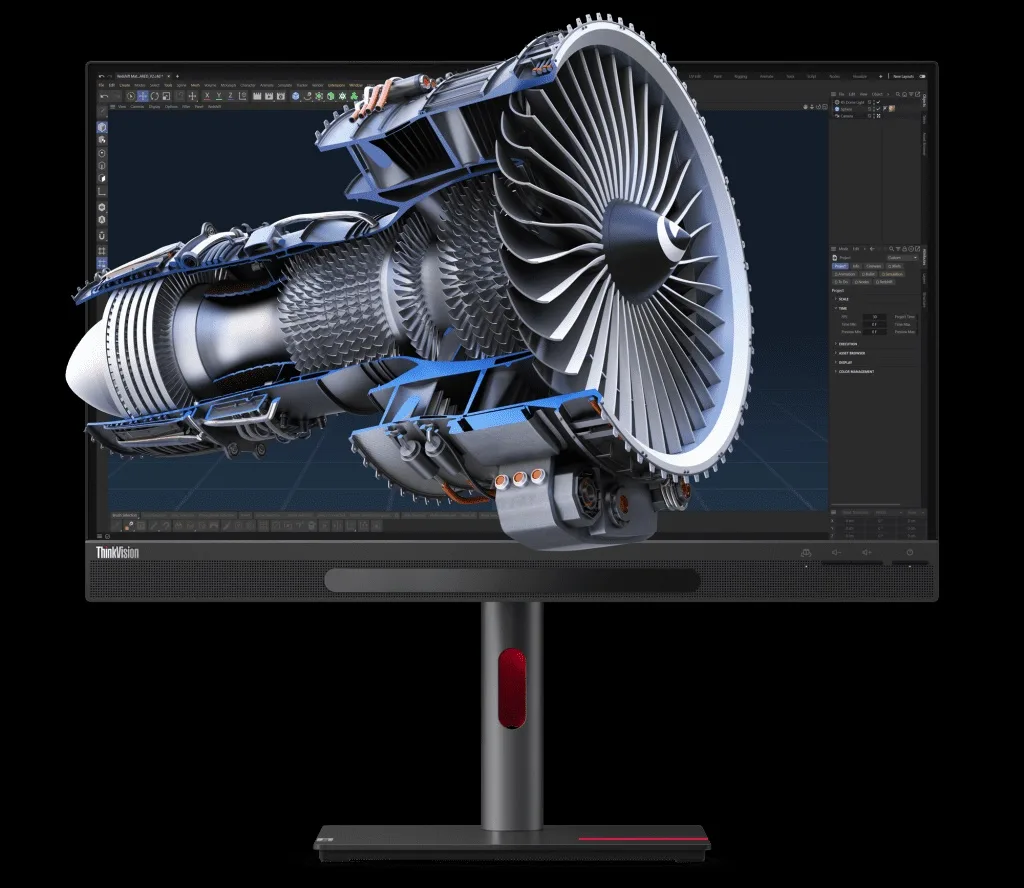Lenovo recently released the ThinkVision 27 3D monitor, a glasses-free 3D product that uses proprietary technologies like a switchable lenticular lens and real-time eye tracking. This overcomes key barriers to 3D adoption like the need for cumbersome glasses and inconsistent experiences based on user positioning.
Lenovo claims the monitor seamlessly switches between 2K and 4K 3D modes, is compatible with over 200 popular software tools, and doesn’t require additional GPU power thanks to its built-in 3D rendering engine. Compared to past 3D tech limited by size and glasses requirements, the ThinkVision 27 3D offers a large 27-inch canvas with 4K clarity, dual 99% professional color spaces, and a consistent naked-eye 3D experience via AI eye tracking.
As for the application of the display, Lenovo claims the ThinkVision 27 3D saves designers time and costs through instant stereoscopic viewing and editing without prototypes. It also provides workflow flexibility by easily toggling between 2D and 3D projects without changing equipment. We talked with George Toh, VP and GM of Lenovo’s visual business, and asked him about the state of 3D displays.


Display Daily: How have the fundamental principles of 3D display evolved in the past decade, and where do you see them heading in the next 10 years?
George Toh: The fundamental principles of 3D display have evolved a lot in the past decade and is evidenced by the growing amount of use cases available now. While 3D displays have commonly been associated with movies and entertainment where audiences need to wear glasses, new technologies and applications are benefiting other disciplines, including engineering, design, animation, medicine, and much more.
However, technology alone cannot account for the massive shift in our workforce. The pandemic transformed our society and we have witnessed a change in both our physical workspace and our idea of collaboration and creative work. According to our research, managing a remote workforce and global teams remains a central task for CIOs.
With the changing societal needs, 3D display technology has also evolved to meet the demands of users and workplaces, becoming more immersive, user-friendly, and adaptable. As we look into the next 10 years, I believe 3D displays will become even more intuitive and realistic. We’ve moved from 3D glasses to glasses-free displays, and we live in a 3D world, so the future will be having displays that are as natural as not having one.
Display Daily: What innovations in pixel technology or screen materials have been particularly influential in the advancement of 3D displays?
George Toh: It is fascinating to look back at the advancements in technology and how they have led to new milestones in 3D displays. For example, higher pixel densities achieved through LCD and OLED innovations have been a steppingstone to the resolution quality and clarity required for 3D viewing. Technologies such as advanced optics and real-time eye-tracking have laid the groundwork for creating 3D holographic displays without the need for glasses. Couple all that with precision manufacturing, an emphasis on color accuracy, and much more, and we have the 3D display technology of today.
Display Daily: How close are we to achieving true “holographic” resolution where the distinctions between virtual and real become almost imperceptible?
George Toh: It is hard to predict how close we are to true “holographic” resolution. Even if the technology is available, society will need years to adapt, adopt and implement, therefore providing a timeline would be unrealistic at this moment.
Display Daily: What progress has been made in widening the viewing angle for 3D displays without compromising on the 3D effect?
George Toh: Efforts to widen the viewing angle for 3D displays is ongoing and solutions can vary depending on the user and use case scenario. For example, widening the viewing angle for a single view will not impact the 3D effect, but will decrease the 3D resolution when it comes to multi-view. It is an industry-wide initiative now and we are working with our partners to optimize our effects.
Display Daily: Can you comment on the integration of gesture recognition or eye-tracking in 3D displays?
George Toh: Our goal is to make the user experience as comfortable and friendly as possible. That’s why I’m excited that our newest glasses-free 3D monitor has advanced technology that allows users optimal viewing regardless of where they are positioned in front of the screen. Through the integration of eye-tracking technology and a switchable lenticular lens, we’ve delivered a more seamless and realistic viewing experience.
We also continue to look at different ways to interact with the display and are always searching for ways to benefit the user experience. With regards to gesture recognition, how attractive would it be to interact with your 3D displays, right?
Display Daily: How do you see 3D display technology converging with or diverging from virtual and augmented reality technologies?
George Toh: We see 3D display, virtual and augmented reality technologies as both converging and diverging. For example, content creators working on metaverse projects are often at the intersection of 3D, AR, and VR, that is why the ThinkVision 27 3D monitor is a great offering for them since it allows them to preview their 3D designs glasses-free 3D and can also be used for AR/VR content.
Each technology has unique advantages and are all useful in their current state, even though their usage will differ. Glasses-free 3D display is easier to adopt and fit into the current user’s workflow, but AR/VR can be more immersive and mobile. Regardless of technologies and how they evolve, we are always looking to equip users with more opportunities to drive forward creativity and innovation.
Display Daily: What do you perceive as the most significant barriers or challenges facing the 3D display industry today, and how can they be overcome?
George Toh: The most significant challenges currently facing the 3D display industry are barriers to user adoption.
First, the reliance of 3D performance on content and hardware design has led to slower user adoption. This overall lack of a definitive industry standard for a continuously evolving 3D technology landscape poses a challenge to evaluating performance against any benchmarks. One of the advantages of the ThinkVision 27 3D monitor is that it does not require additional computing power from your PC for 3D rendering – it comes with its own built-in engine that manages it. That’s why users don’t need to worry about upgrading their PC to support the 3D monitor.
The industry also faces challenges with 2D and 3D display incompatibility both in hardware and software. While some monitors are strictly 3D, the ThinkVision 27 3D monitor can seamlessly switch between 2D and 3D without missing a beat. Traditionally, creators had to go through a process of designing in 2D, building prototypes, and then revising. But with this monitor, you can instantly see your 3D designs and make changes as needed.
Display Daily: How are issues of compatibility and standardization being addressed in the 3D display ecosystem?
George Toh: Issues with compatibility and standardization must be solved to guarantee a seamless adoption, and we have tackled them head on. Going back to the previous answer, the ThinkVision 27 3D monitor is compatible with any content or software that can display side-by-side 3D images. It also has an SDK for developers to build 3D applications. Computer power compatibility can also be an issue, so we’ve built-in a 3D engine to manage rendering in the monitor to ensured that content creators and designers using this monitor will not need to upgrade their existing equipment.

